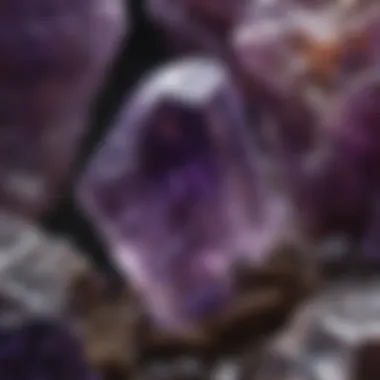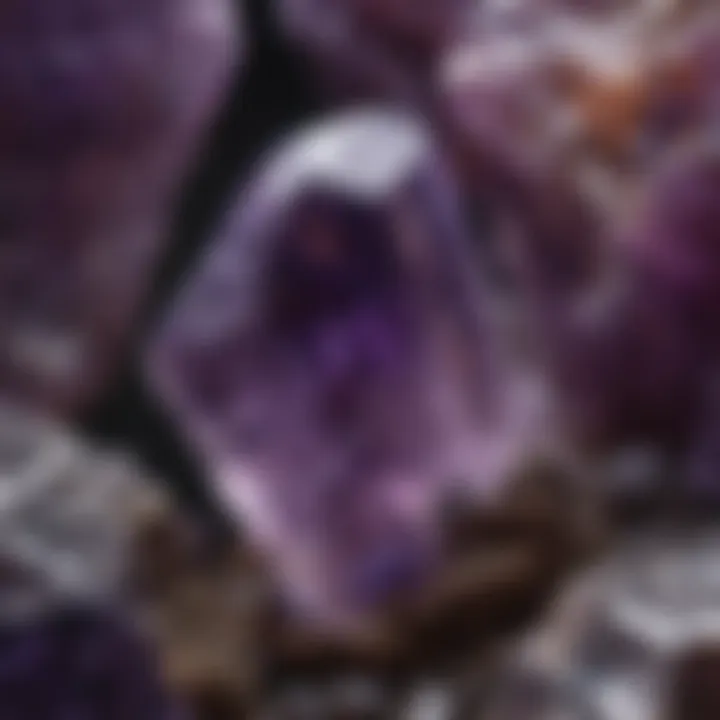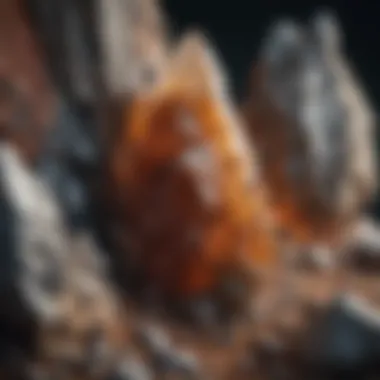The Intricacies of Large Crystal Rocks: A Comprehensive Overview


Intro
Large crystal rocks evoke a sense of wonder in those who study and collect them. Their formation spans millions of years, and the processes involved are as intricate as the crystals themselves. As we navigate through this article, we will discuss their characteristics, geological origins, and their roles across various fields. This exploration aims to provide an enriching perspective for both enthusiasts and novices.
Featured Collectible of the Month
Overview
This month, we shine the spotlight on the stunning amethyst geode. Known for its vibrant purple hue and striking geometric formations, the amethyst geode is more than just a visual wonder. It has become a sought-after collectible among rock and mineral enthusiasts. The artifact showcases a delicate balance of aesthetics and geological significance, making it a perfect subject for our featured collectible.
Historical Significance
The amethyst has held a prominent place in human culture for centuries. Ancient Greeks considered it a protection against intoxication, while various civilizations viewed it as a symbol of power and spirituality. Notably, the British Crown Jewels include a commanding amethyst piece, further solidifying its cultural relevance. Understanding these historical context adds depth to the appreciation of this beautiful geode.
Identification Techniques
Identifying large crystal rocks can be both an art and a science. A certain attention to detail is crucial for collectors and enthusiasts.
Visual Characteristics
When observing a large crystal rock, several visual traits become apparent:
- Color: The dominant color provides initial clues about the type of crystal. For instance, blue may suggest lapis lazuli, while clear or translucent could indicate quartz.
- Clarity and Transparency: The quality of clarity can vary. Higher quality pieces exhibit fewer inclusions, while more opaque specimens reveal different characteristics.
- Crystal Structure: Familiarity with crystal formations allows for better identification. Structures like hexagonal prisms in quartz or cubic formations in fluorite have distinct shapes.
Resources for Identification
Several resources can assist in the identification process:
- Online platforms like Reddit, where communities discuss various specimens, can be highly informative.
- Books such as "Minerals of North America" provide comprehensive guides aiding in identification.
- Websites like Wikipedia and Britannica have extensive information on specific minerals and their properties.
Remember, proper identification not only enhances collection experience but also fosters a deeper connection with these geological wonders.
Prelims to Large Crystal Rocks
Large crystal rocks have always been a source of fascination due to their remarkable size and beauty. Their unique formation processes offer invaluable lessons in geology. Understanding these crystals provides insights into not only the Earth's geological history but also their broader significance in various cultural contexts.
Within this article, we will explore these captivating formations in detailed sections that cater to both enthusiasts and seasoned collectors. The aim is to examine their defining characteristics, formation processes, and their significance across different domains. This comprehensive overview will shed light on how large crystal rocks are more than mere collectibles; they possess deep cultural and scientific relevance.
Defining Large Crystal Rocks
Large crystal rocks are geological formations made up of one or more minerals that have grown to a significant size. These can include notable varieties such as quartz, amethyst, and obsidian. Typically, they form through geological processes that allow for slow crystallization, resulting in visually stunning specimens. The term 'large crystal' indicates not only a singular crystal formation but can also refer to clusters that exhibit remarkable geometric shapes and clarity.
The physical properties of large crystal rocks, including their transparency, color, and internal structure, are intricate attributes that collectors value. Dimensions can vary widely, with some specimens reaching impressive sizes, making them sought after in both personal collections and galleries.
Significance in Geology and Culture
The significance of large crystal rocks extends beyond their aesthetic appeal. In geology, they serve as indicators of the conditions in which they formed. For example, certain minerals can reveal the temperature and pressure environments of the Earth’s crust. By studying these minerals, geologists can infer much about the planet's history and the processes that shape it.
Culturally, large crystal rocks have held various meanings across societies. Ancient civilizations often attributed mystical properties to specific crystals. For instance, amethyst has been historically linked to clarity of mind and emotional balance. Understanding these cultural perceptions adds another layer of depth to the knowledge of these geological wonders.
"Large crystal rocks serve not only as specimens of geological processes but also as historical markers of human interaction with nature."
In summary, large crystal rocks constitute a rich field of study that spans geographic, historical, and cultural domains. Their intrinsic value positions them as both scientific subjects and objects of cultural reverence.
Geological Formation of Large Crystal Rocks
The geological formation of large crystal rocks is a fundamental topic within the study of mineralogy and earth sciences. Understanding how these impressive structures develop not only enhances our appreciation of the natural world but also aids collectors and researchers in identifying and valuing crystal specimens. Crystals form through intricate processes influenced by various geological factors. This section provides a deep dive into the key elements involved in the formation of these remarkable geological features.
Crystal Growth Processes
The growth of crystals is a complex sequence that can occur through various mechanisms. Primarily, crystals develop when a mineral solution becomes supersaturated, allowing molecules to bond and arrange in a highly ordered structure. The two main processes for crystallization are:


- Cooling from a Melt: When molten rock cools, minerals crystallize as the temperature drops, allowing atoms to organize. For instance, when lava solidifies, significant quartz and feldspar crystals may form.
- Evaporation: As water evaporates, dissolved minerals take form. This is common in arid environments where salt flats often display robust crystal formations.
In addition to these, other processes, such as sublimation aand precipitation, also play roles in crystal growth. Each of these methods produces unique crystal morphologies that reflect the conditions under which they formed.
Environmental Conditions for Formation
Crystal formation occurs under various environmental circumstances that greatly influence the final appearance and quality of the rocks. Some vital conditions to consider include:
- Temperature: The rate of cooling can affect crystal size. Slow cooling allows larger crystals to grow, while rapid cooling often results in smaller, less structured formations.
- Pressure: High-pressure environments can lead to different transformations within the crystal structure. For example, while quartz usually forms under low-pressure conditions, in metamorphic settings, it can yield new minerals such as garnet.
- Chemical Composition: The elements present in the surrounding environment directly affect the mineral composition of the crystals. The presence of specific ions can dictate the type of crystals formed.
- Fluid Dynamics: The movement of fluids carrying dissolved minerals also plays a role. Steady, slow-moving fluids allow for more orderly crystal growth, while turbulent flows can disrupt this process.
Understanding these environmental conditions is essential for rock and fossil collectors. It helps in predicting where large crystal rocks may be found and the types that might be expected in specific geological settings.
Types of Large Crystal Rocks
Understanding the various types of large crystal rocks is essential for collectors and enthusiasts. Each type possesses unique properties, characteristics, and applications. This section will discuss the three prominent categories of large crystal rocks: quartz crystals, amethyst and other varieties, and obsidian as well as volcanic rocks. Recognizing these different types allows individuals to better appreciate the natural world and informs best practices for collection and preservation.
Quartz Crystals
Quartz is one of the most abundant minerals found on Earth. Its crystalline structure is primarily composed of silicon and oxygen, leading to a variety of forms and colors. The clarity of quartz crystals can range from completely transparent to opaque, and this versatility contributes to its extensive use in both decorative and functional items.
Quartz is particularly valued in the field of geology and for its various industrial uses. This mineral can be used in electronics, glassmaking, and even in watches due to its piezoelectric properties, which enable it to convert mechanical energy into electrical energy. When collecting quartz, pay attention to the size, clarity, and color. Clear quartz is often sought after for its aesthetic appeal, while other varieties such as rose quartz, smoky quartz, or citrine may attract collectors for their unique hues.
Amethyst and Other Varieties
Amethyst is a purple variant of quartz and is renowned for its beauty and alleged healing properties. The color of amethyst ranges from light lavender to deep purple, influenced by the presence of iron and other trace elements during its formation. Collectors often prize larger amethyst geodes and clusters, which display striking visual characteristics.
Apart from amethyst, there are many quartz varieties such as citrine, which presents a yellow to orange hue due to iron impurities, and smoky quartz, characterized by its brown to black shades. Each variant carries its appeal based on color and form. When targeting these varieties, it is crucial to understand their unique geological formation processes, which help in identifying authentic specimens.
Obsidian and Volcanic Rocks
Obsidian forms from quickly cooling lava, resulting in the glassy texture that is attractive to many collectors. The deep black color can exhibit iridescent sheens or varied colors depending on the mineral content and the rate of cooling. Obsidian is primarily used for ornamental purposes and in jewelry, but it has historical significance too, as ancient cultures utilized obsidian for tool-making due to its sharp edges.
Collecting obsidian requires an understanding of where to find it. Many locations globally yield obsidian, especially areas with a volcanic history. It is important to ensure that collection practices are ethical and sustainable, respecting both the environment and local regulations. This leads us to consider the significance of ethical implications surrounding the collection of crystal rocks.
Collecting Large Crystal Rocks
Collecting large crystal rocks is not just a hobby for many; it is a profound connection with nature's artistry. The practice involves understanding the geological heritage of these specimens, as well as the ethical and practical dimensions surrounding their collection. With a guided approach, enthusiasts can enhance their collections while respecting the environment and local laws.
Identifying Authenticity
When collecting large crystal rocks, authenticity is paramount. Many fakes and imitations exist in the market, often made from synthetic materials that might superficially resemble natural specimens.
To determine authenticity, consider the following factors:
- Physical Characteristics: Examine the color, clarity, and brilliance. Genuine crystals typically reflect light differently than imitations.
- Crystal Structure: Most authentic large crystal rocks exhibit specific crystalline formations. Familiarity with different types can help in this assessment. For instance, natural quartz often has unique striations or inclusions.
- Weight and Density: Real crystals tend to be heavier than their synthetic counterparts. Weighing the specimen or comparing it to known samples can provide insight.
- Source and Documentation: Reliable sellers often provide provenance or documentation. Having this background can offer reassurance about a crystal’s authenticity.
"Being informed and vigilant will save collectors from potential disappointments and financial losses."
Strategies for Successful Collection
Embarking on a collecting journey requires careful planning and execution. Below are some effective strategies to ensure a fruitful collecting experience:
- Research Locations: Identify regions known for rich deposits of large crystal rocks. Places like Arkansas for quartz or Brazil for amethyst can be prime targets.
- Join Local Clubs: Engaging with local rock and mineral clubs can provide valuable tips and insights. These communities often share knowledge about best practices and collecting local varieties.
- Use Proper Tools: Equip yourself with necessary tools. A good hammer, safety goggles, and a sturdy backpack are essentials. It can make the difference between a successful outing and a disappointing trip.
- Respect Nature: When collecting, always follow a sustainable approach. Avoid overharvesting and ensure that you leave the environment as you found it.
- Document Your Finds: Keeping records of where and when crystals were found can enhance the story of your collection. Documenting their characteristics can also aid in future assessments of authenticity.
By adhering to these methods, collectors can avoid common pitfalls while enjoying the unique experience that comes from gathering large crystal rocks.
Care and Preservation of Large Crystal Rocks
Caring for and preserving large crystal rocks is crucial for maintaining their aesthetic appeal and structural integrity. Proper care ensures that these geological specimens remain valuable over time, whether for display or collection purposes. The focus on preservation also sustains the natural beauty that these crystals exhibit. By understanding specific techniques and recommendations, collectors can enhance the longevity of their crystals while preventing damage from pollutants and environmental factors.
Cleaning Techniques
Cleaning large crystal rocks is a delicate process that requires consideration of their unique properties. It is essential to understand that certain cleaning methods may be harmful to specific types of crystals. Therefore, it's important to identify the type of crystal before proceeding.


- Gentle Dusting: For surface dirt, a soft microfiber cloth can effectively remove dust without scratching the crystal's surface. Avoid using abrasive materials that may cause scratches.
- Soapy Water: If deeper cleaning is necessary, use lukewarm water mixed with a gentle soap. Dip a soft cloth in the soapy solution, wring it out to avoid excess moisture, and gently wipe the crystal. Follow up by rinsing it under running water.
- Avoid Chemicals: Do not use household cleaners or chemicals, which can tarnish, etch, or otherwise damage the crystal. Natural substances are often preferred for their efficacy in cleaning without causing harm.
- Drying: After cleaning, it is crucial to let the crystal air dry completely. Storing a damp crystal can lead to mold or other moisture-related issues that could compromise its integrity.
"Proper cleaning techniques can greatly increase the lifespan and visual appeal of large crystal rocks. Collectors should prioritize gentle methods to safeguard these natural treasures."
Storage Recommendations
Storage of large crystal rocks is another vital aspect of care. Proper storage prevents physical damage and helps maintain the appearance of the crystals. Here are some recommendations for safe storage:
- Temperature Control: Store crystals in climate-controlled environments. Extreme temperature fluctuations can cause cracking or fading.
- Avoid Direct Sunlight: Ultraviolet light can lead to color changes and deterioration. Keep crystals away from direct sun exposure, using display cases if necessary.
- Space Between Crystals: When storing multiple crystals, ensure there is adequate space between them to prevent scratching or chipping. Bubble wrap can provide cushioning during storage.
- Support Structures: For larger specimens, consider using stands or pads to provide additional support. These can help distribute weight and prevent stress on fragile pieces.
- Regular Checks: Frequently inspect stored crystals for any signs of deterioration. Early detection of issues can lead to timely corrective measures, preserving the crystal's value and beauty.
By employing these cleaning techniques and storage recommendations, collectors can greatly enhance the longevity and aesthetic value of their large crystal rocks.
The Aesthetic Value of Large Crystal Rocks
Large crystal rocks possess a distinct aesthetic value that transcends mere visual appeal. Their formations, colors, and textures contribute significantly to both personal expression and the broader design landscape. Collectors and enthusiasts alike recognize that these natural wonders are not just geological specimens; they are also artistic elements that can enhance various environments. Attention to the aesthetic qualities of crystal rocks elevates them from simple objects to works of art, influencing the way they are perceived and used in everyday life.
Use in Interior Design
Large crystal rocks have increasingly become valuable assets in interior design. Designers often select unique formations to create focal points in a room, utilizing their natural colors and structures to complement overall aesthetics. Whether incorporated as centerpieces on tables or used as decorative elements on shelves, these rocks add organic beauty and a sense of calm to spaces. The play of light through crystal formations can also transform a space, creating subtle reflections and enhancing ambiance.
In addition, large crystals are often favored because they exhibit a variety of hues, which makes them versatile in pairing with different design schemes. For instance:
- Amethyst can introduce rich purple tones, providing a regal atmosphere.
- Clear quartz can contribute to a minimalistic and airy feel.
- Rose quartz brings warmth and intimacy.
Considerations also extend to placement. Strategically positioning large crystal rocks near natural light sources can amplify their brilliance, leading to a more inviting and dynamic environment. The texture and natural imperfections of these rocks foster a connection with nature, contrasting beautifully against man-made materials.
Role in Art and Decoration
The artistic significance of large crystal rocks cannot be understated. Artists often incorporate these geological specimens in various forms of artwork and decoration. Sculptures made from large crystal rocks, for instance, can embody raw beauty combined with artistry. In this sense, the crystals serve as both a medium and a message, portraying the interplay between nature and human creativity.
Moreover, these rocks can play essential roles in spiritual art and holistic decoration. Here, they may be included to promote wellness or serenity, reinforcing their significance beyond aesthetics. For art collectors, owning a piece made from uniquely shaped or vibrantly colored crystals offers a statement of individuality.
Essentially, large crystal rocks enable artists and designers to merge nature's beauty with human creativity, elevating ordinary spaces into extraordinary realms. The value of these rocks is, therefore, not merely visual; it is an integration of the natural world into the folds of artistic expression.
The use of large crystal rocks in art and design serves as a reminder of the inherent beauty in nature, connecting people to the earth in contemporary narratives.
In summary, the aesthetic value of large crystal rocks encompasses their role in enhancing interior designs and inspiring artistic endeavors. These rocks are not only appreciated for their physical characteristics but also for their ability to evoke emotion and encourage mindfulness in various settings.
Scientific Applications of Large Crystal Rocks
The field of large crystal rocks extends beyond aesthetics and collection. Their scientific applications play a significant role in advancing knowledge across various disciplines. These materials are not just beautiful; they have utility in mineralogical research and technological innovations. Understanding these applications is essential for those interested in the broader implications of their collection and utilization.
Mineralogical Research
Large crystal rocks provide invaluable insight into Earth's processes. They are crucial in studying mineral composition, formation mechanisms, and environmental conditions affecting geological changes. By examining these crystals, researchers can identify the history of geological events, including volcanic activity and tectonic shifts.
Crystals such as quartz, feldspar, and calcite serve as natural archives of environmental conditions. Researchers can date these rocks and understand the timings of various geological phenomena. This makes large crystals not only attractive to collectors but also essential for scientists conducting mineralogical analysis.
Analysis techniques commonly used include:
- X-ray diffraction: This method helps determine the crystalline structure of minerals.
- Scanning electron microscopy: This vein of study reveals finer details of crystal surfaces and compositions.
- Mass spectrometry: Used to analyze isotopes for age dating and elemental composition.
These research methods can lead to significant findings, impacting areas such as environmental science, natural resource management, and even archaeology.
Crystals in Technology
The use of large crystal rocks has seeped into technological advancements. Crystals have unique properties that lend themselves well to various modern applications. For instance, quartz crystals are widely used in electronics due to their piezoelectric properties. When subjected to mechanical stress, quartz generates electric charges, making it ideal for components in watches, smartphones, and radios.
The technological implications include:
- Optical devices: Crystals such as calcite and quartz are utilized in lasers and optical filters.
- Frequency control: Quartz crystals help regulate the frequency in oscillators found in communication devices.
- Research instrumentation: Large crystals aid in developing highly sensitive detection machines, improving the accuracy of experiments.
Notably, innovations in engineering and material science are continually evolving, revealing new potential uses for crystal rocks in technology. Further research may unlock additional applications in areas like telecommunications and renewable energy.


"The study of crystal rocks is not just a pursuit of beauty; it is a gateway to understanding the universe's physical laws and advancing technology."
Cultural Significance of Large Crystal Rocks
The cultural significance of large crystal rocks intertwines deeply with human history, beliefs, and practices. Across various societies, these natural formations have been revered for their beauty, rarity, and purported mystical properties. Such cultural frameworks contribute to a broader understanding of large crystal rocks beyond their geological properties.
One significant aspect is the role these crystals play in rituals and spiritual practices. Often, cultures have incorporated crystal rocks into ceremonies and healing practices, reflecting both reverence and practical beliefs. For instance, many indigenous tribes in North America have used quartz and other crystals in rituals intended for protection, healing, and community bonding. These practices not only emphasize the spiritual value of the crystals but also highlight their role in maintaining connections within communities.
Historical Uses in Rituals
Historically, the use of large crystal rocks in rituals traces back thousands of years. Ancient civilizations such as the Egyptians utilized crystals like lapis lazuli and turquoise in tombs and rituals, believing they provided safety in the afterlife and spiritual clarity. Furthermore, during the Medieval period, gemstones were often associated with specific virtues, influencing their use in sacred rituals.
- Healing Properties: Many practitioners believed that certain crystals held powers to cure ailments and ward off negative energies. Amethyst, for example, was thought to inspire clarity and balance, creating a meditative atmosphere for practitioners.
- Protection: Large crystal rocks, especially those with unique shapes or vibrant colors, were frequently used as talismans. The act of wearing or carrying these stones was believed to offer protection from misfortune or harm.
- Ceremonial Objects: Larger crystal formations have been prominently displayed during ceremonies, acting as focal points for prayers and intentions. Their physical presence adds a visual element of beauty and substance to the spiritual experience.
These historical practices speak to a long-standing appreciation for the intrinsic and extrinsic values associated with large crystal rocks, embedding them into the fabric of human culture.
Myths and Legends Surrounding Crystals
Myths and legends surrounding large crystal rocks often add layers to their cultural significance. Various cultures have constructed narratives around the origins and powers of these crystals, enhancing their mystique and appeal.
- Creation Myths: In some cultures, stories exist about how specific crystals were formed from the tears of gods or the remnants of celestial battles. These tales serve not only to explain the existence of certain crystals but also to elevate their status as sacred objects.
- Symbolism in Folklore: Large crystal rocks frequently appear in folklore, symbolizing luck, love, and strength. For instance, jade is celebrated in numerous Asian traditions for its association with prosperity and healing. Tales of heroes discovering magical crystals often symbolize the transformative potential of these stones in human life.
- Healing and Protection Narratives: Many legends attribute specific healing properties to crystals, suggesting that they can communicate with the spirit world. Such beliefs persist in various modern practices, indicating an enduring legacy.
Ultimately, the myths and legends surrounding large crystal rocks encapsulate the values, fears, and aspirations of the cultures that revere them. This ongoing narrative continues to inspire various forms of art, storytelling, and spiritual engagement, making crystal rocks a rich subject for exploration in contemporary society.
"Crystals embody a natural form of wonder, bridging the gaps between science, spirituality, and culture."
Understanding these cultural dimensions enriches the dialogue among collectors, enthusiasts, and scholars interested in large crystal rocks. It encourages a multi-faceted appreciation that goes beyond simple aesthetics.
Ethical Considerations in Collecting
The subject of ethical considerations in crystal collecting holds great significance, not only for enthusiasts and collectors but also for a broader circle that includes conservationists and geologists. This topic emphasizes the need for responsible practices in obtaining large crystal rocks, thereby influencing the overall impact on the environment, societies, and the sustainability of these natural resources. Recognizing these concerns ensures that collectors engage in methods that respect both the geological and cultural heritage associated with these specimens.
Understanding ethical collecting can enhance the reputation of collectors and promote practices that protect natural habitats. Encouraging sustainable methods involves being informed about the sources of crystals and striving to minimize environmental disturbances. It also includes fostering a culture of respect for indigenous lands and the rights of local communities impacted by collection activities.
"Ethical collecting is not just a responsibility; it is a commitment to preserving the beauty and integrity of our natural world."
When collectors prioritize ethical practices, they send a message that they value the conservation of the earth’s resources. This perspective creates a responsible community that acknowledges the interconnectedness of human activities and the environment.
Sustainability in Collecting Practices
Sustainability is a crucial aspect of collecting large crystal rocks. Collectors should consider how their actions impact the environment. Over-collection can lead to depletion of resources and endanger habitats. It's vital to approach collecting with care and mindfulness. Two main elements to consider include:
- Education About Sources: Before collecting, one must research where the crystals come from. This encompasses understanding how these stones were extracted and whether the methods used were harmful to the environment.
- Conservation Practices: Adopting practices such as selective collecting, where only a few specimens are taken, can help maintain balance in nature. Collectors should avoid purchasing crystals from questionable sources that promote illegal mining activities.
Collectors who practice sustainability contribute positively to the long-term preservation of crystal resources.
Legal Aspects of Crystal Trade
The legal aspects surrounding the trade of large crystal rocks are indispensable for responsible collecting. The lack of awareness regarding laws can lead to severe repercussions not just for the collector, but for ecosystems as well. Collectors need to be informed about specific regulations that govern the collection and sale of crystals in various regions. Key points include:
- Local Regulations: Different regions have unique laws concerning the collection and trade of natural resources. It is essential to understand these regulations to avoid illegal sourcing.
- International Trade Laws: Crystals may fall under certain trade regulations when exported or imported. Knowing the laws, such as the Convention on International Trade in Endangered Species of Wild Fauna and Flora, can prevent legal complications.
By considering both sustainability and legal aspects, collectors can ensure that they practice ethical collecting. This not only protects the environment but also fosters a culture of respect and stewardship within the collecting community.
The End
The analysis of large crystal rocks culminates in a reflection on their multifaceted importance. This article has traversed the geological, aesthetic, and cultural dimensions of these remarkable natural specimens. Understanding the future trends in crystal collecting is crucial for enthusiasts seeking to enhance their collections while respecting ethical considerations. Strategies that emphasize sustainability and legal compliance are essential for the ongoing enjoyment of both collectors and the natural environment.
Future Trends in Crystal Collecting
The realm of crystal collecting is evolving. With increased awareness about ethical sourcing, collectors are more inclined towards sustainability. Innovations in technology are facilitating better methods for genuine identification. This will greatly assist in distinguishing natural crystal rocks from synthetics. Furthermore, digital platforms present new opportunities for collectors to connect and share information about crystals. Virtual exhibits or e-commerce sites can increase access to unique finds that might otherwise be geographically limited.
Additionally, educating new collectors about responsible practices will become a focal point. As the interest in crystals grows, so does the responsibility to maintain the sustainability of sources. Understanding local laws regarding collection is paramount, as regulations vary significantly across regions. Overall, the future will likely embrace both technology and ethical considerations, enriching the collecting community.
Final Thoughts on Large Crystal Rocks
Large crystal rocks are more than mere geological formations. They hold cultural significance, aesthetic charm, and scientific value. Engaging with these specimens opens doors to a deeper appreciation of Earth’s processes and history. They prompt questions about our relationship with nature and the responsibility we bear as custodians of these treasures.
The intrinsic beauty of these rocks can enhance personal enjoyment, from interior design settings to larger community displays. For rock and fossil collectors, the allure lies in not only acquiring these specimens, but also in understanding their stories. Each piece carries its unique narrative, echoing the ages and environments from which it emerged.



